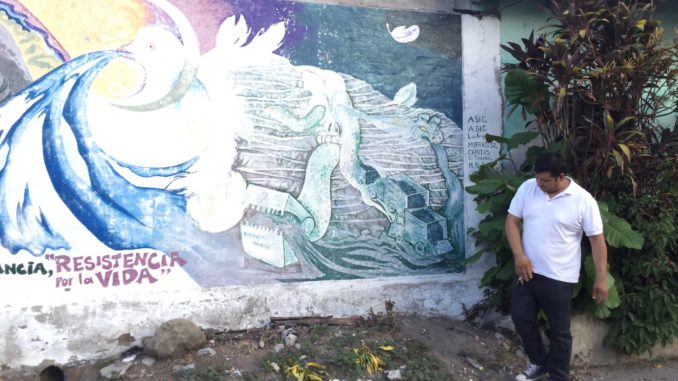The January 22, 2021, episode of CounterSpin brought together archival interviews about the Flint water crisis from Chris Savage, Talia Buford and Peggy Case. This is a lightly edited transcript.

Cartoon by Politico‘s Matt Wuerker.
Janine Jackson: Welcome to CounterSpin, your weekly look behind the headlines. I’m Janine Jackson. This week on CounterSpin: Michigan’s attorney general has indicted nine state officials, including former Gov. Rick Snyder, the state’s former health director and two of the emergency managers of the city of Flint, for exposing at least 100,000 people to dangerous levels of lead in their drinking water, and for an outbreak of Legionnaires’ disease that killed at least 12 people and sickened many more.
In an op-ed for The Hill, Michigan Congressman Dan Kildee called the 2014 decision to switch the source of Flint’s drinking water “one of the greatest environmental injustices in our lifetimes.” Which is true, but “the environment” didn’t do it: It’s often forgotten that Flint was a crisis of democracy. Decision-making had been taken out of the hands of Flint’s elected officials and given to an “emergency manager” tasked with reining in costs—a system that seems to be used disproportionately in communities of color, taking decision-making out of community hands but leaving them to deal with the fallout of those decisions.
There’s been a $640 million settlement of class action lawsuits, but Michigan Radio reports that many civic leaders say the deal presents inappropriate hurdles—children might not get their settlement if they don’t undergo a specific bone lead test—and some question how money could ever compensate Flint residents for months and months of washing and bathing and cooking with bottled water to avoid exposing themselves and their families to a neurotoxin, all while officials deflected and denied and belittled their concerns.
We’ve talked about Flint on CounterSpin, in its particulars and in terms of how it fits into bigger questions around environmental racism and resource control and local governance. In light of the renewed attention around the story—which has not ended, even as media have looked away—we’re going to revisit some of those conversations today.
You’re listening to CounterSpin, brought to you each week by the media watch group FAIR.
***
Janine Jackson: While Flint’s water became a symbol—a meme, even, around the world—of environmental racism and government indifference, it was mainly local reporters who really tracked the political actors and actions behind what was not at all a natural disaster.
In January 2016, we talked with Chris Savage, owner/publisher of the Michigan-based Electablog.com, about the chain of events.

Chris Savage: “The ironic part about this, and the really just disgusting part about this, is that that phosphate treatment would have cost them about $60 per day to do. It was very inexpensive to do.”
Chris Savage: The whole thing really began in 2013. Prior to that, Flint had been considering changing where it got its water. It was at the time getting its water from the city of Detroit, through the Detroit Water & Sewage Department; they had a nearly 50-year contract with them. However, the water was very expensive; they had some of the highest water costs in the country, actually, in Flint, Michigan.
They joined up with other regional concerns, like Genesee County and other groups around the area, and decided to form what was called the Karegnondi Water Authority. And they’re building a pipeline and a water treatment plant to provide their own water, rather than purchasing it from Detroit. That happened in April of 2013.
Several days after they did that, the Detroit Water & Sewage Department exercised its option to cancel their current contract with the city of Flint, which meant they had to give one-year advance notice. This was done, by the way, with Detroit being under an emergency manager as well. So both cities were actually under the control of emergency managers at the time, who were making all of the decisions for the local government.
So what transpired in the following year was that Flint had to make some decisions about where they were going to get their water, or if they were going to renegotiate their contract with Detroit. Just prior to when Detroit’s contract ended with them, in April of 2014, the Detroit Sewer & Water Department sent Darnell Earley, who was at the time the Flint emergency manager, a letter saying you can stay on our system, you’re not being kicked off, but they were going to renegotiate the contract. And of course, because of this, their water rates were going to go even higher. And I find some brutal irony in this, that both cities were under emergency managers, and yet you have one city basically exploiting the other city for higher water costs.
JJ: Right.
CS: So Darnell Earley at that point just sent them a letter back, saying thanks but no thanks. He had made the decision they were going to go to the Flint River. And in April of 2014, that is when that happened. And that really was the fateful decision, that decision not to remain on Detroit water, but to switch to the Flint River in the interim, while the Karegnondi pipeline was being completed.
The idea that they would go to Flint had been considered in the past, and a report was sent to the state of Michigan in 2013, telling them that going to the Flint River would require considerably more water treatment, including phosphate treatments to prevent the mineral scale and biofilm on the insides of people’s pipes from being eroded away and revealing the lead solder underneath. And it’s that lead solder in the pipelines going from the main water line in the streets to people’s homes that is the source of the lead in people’s drinking water.
They made the switch in April 2014. Almost immediately, people in Flint began to report this disgustingly discolored water coming from their taps. The water smelled foul, people were getting rashes, people were getting sick. They found that there were high levels of E. coli, so there was a boil-water alert for some time. They began treating with chlorine to fix that problem. And because of the overtreatment with chlorine, it started creating trihalomethanes, which are a byproduct of disinfection. They exceeded the Clean Water Act’s regulations on those. That had to be treated. So they had a lot of problems before the lead issue manifested itself.
It took a while for that water of the Flint River, which is more corrosive than the Detroit River, to sort of erode away this coating that’s on the inside of these pipelines. And it was basically around January of 2015 that the lead problem started to become manifest.
Reports that were being sent to Michigan’s Department of Environmental Quality, which is in charge of approving all water treatment plants for municipalities, they had been doing testing according to guidelines, and they were using the guidelines incorrectly. They were supposed to be testing 100 different high-risk homes at the tap and then, if the lead level in the 90th percentile was above 15 parts per billion, then they were supposed to take action. This is required by federal law. They had only taken actually 72 samples, which they were supposed to take 100, and some of those had spiked pretty high, putting them in the action zone in the 90th percentile. And so people that were responsible for that reporting were instructed by DEQ to remove two of the samples, and that brought them down below the action level of 15 parts per billion, and so they could continue on without further treatment.
The ironic part about this, and the really just disgusting part about this, is that that phosphate treatment would have cost them about $60 per day to do. It was very inexpensive to do, this phosphate treatment, which is very effective at maintaining that film that covers the lead, and protects the water from being exposed to lead. But the DEQ signed off on the treatment that did not include the phosphate, and that’s why the Snyder administration—Governor Snyder is our governor—and his administration is complicit in this.
I do give a lot of credit to our local media. I don’t always do that, Janine, but the Detroit Free Press, the Detroit News, MLive, these organizations have done a very good job over the last couple of years in following this story and making sure that people knew what was going on. In an interesting turn, the ACLU actually hired an investigative journalist, Curt Guyette, and he’s done a lot of the FOIA work, and has revealed a lot of the information that we have today that has shined a light on the Snyder administration, and the ways that they have so tragically failed the Flint residents.
***
Janine Jackson: There were those who claimed that the fact that Flint is a predominantly African-American and predominantly poor community had nothing to do with the poisoning of their water. We talked around such people in February 2016 with Talia Buford, then a reporter at the Center for Public Integrity, working on a series called “Environmental Justice, Denied.” She filled us in on the role of agencies like the EPA.

Talia Buford: “When you have something ‘not in my backyard’ from these more politically connected people, it still goes in someone’s backyard.”
Talia Buford: I think that what we see in Flint is a failure on a number of different levels, a failure from the city level to the state level to the federal level. EPA has a role, of course, as an overseer of the Michigan Environmental Agency. The Michigan department should be probably the one that has a bigger responsibility than the federal agency, since they are working in conjunction with the state, but I think that everyone here had something that they did where they fell off the job.
JJ: A headline of a piece that you co-wrote recently was “Environmental Racism Persists, and the EPA Is One Reason Why.” Those are strong words. You’ve talked about the Office of Civil Rights. What did your investigation turn up about the actual track record of that office?
TB: In our investigation, we looked at more than 15 years of complaints that citizens had filed to the EPA Office of Civil Rights. These are minority communities, often low-income but not always, who are saying, we live next to a sewage plant that makes it horrible for us to sit outside on our porches, or there are pesticides being sprayed on the fields next to our schools.
So what we found is that over the 22-year history of the office, the agency had only had about 300 complaints, and they’ve never made a formal finding of a Title VI violation. They’ve made one preliminary finding, and there have been some investigations, but they’ve never come out and said, Texas or Indiana or whatever state, you are violating Title VI of the Civil Rights Act.
And that struck us as something—especially over a decades-long history—that you can’t find one bad actor, when we know that there are so many of these cases; we hear about them all the time. To hear that there’s been no wrongdoing, it struck us as kind of odd.
So in our investigation, what we also found is that only 12 of those cases that the EPA has found, they’ve closed with any actual official action. That means they’ve either negotiated or had some sort of informal settlement. The rest of them were all resolved among the complainants or the agencies, or dismissed. And that even beyond that, there are several cases, almost 20, that have been just waiting in limbo, waiting for EPA to act in some way. In some cases, they’ve been waiting more than a decade.
JJ: Your thoughts on journalistic coverage of this?
TB: I’m thinking about it in the context of Flint, and I think that a lot of the local news media is paying attention, and there’s been some amazing reporting and watchdogging that’s been coming out of the Detroit Free Press and the Flint Journal. But a lot of this really comes down to people not being listened to—either by state officials and, in some cases, by the national media.
There is so much information that’s just out there if you look for it. Our series was built on data that we pulled from the EPA that was publicly available. We were able to get it through a FOIA request. We actually created a database and made it public on our website, so that people can tell their own stories using our data as well.
So I think that these stories like Flint, or other stories out of the Office of Civil Rights even, can be a jumping off point for us to just start asking more about our communities and asking more about the world that we live in, and looking for the data to back those questions up.
***
Janine Jackson: We spoke with Talia Buford again in July 2017, after Michigan’s Attorney General brought involuntary manslaughter charges against five officials, one of whom—Health and Human Services Director Nick Lyon—had been reported saying, “Everyone has to die of something.” Now at ProPublica, Talia Buford gave us some history of environmental justice as a state concern.
TB: It popped up during the civil rights movement, but it really took hold in the early ’80s, when citizens in North Carolina really pushed back on the state choosing to dump contaminated soil in a landfill near their homes. After that happened, the federal government started to take notice. There were some studies by EPA, and then there was a church group that also did a really instrumental study on just where toxic facilities were sited around the country.
And after that, President Bush—this is George H.W. Bush—at that point decided to implement the Office of Environmental Equity, which is today the Office of Environmental Justice. That was in ’92.
Two years later, President Clinton gave us, I guess, the biggest win for the environmental justice community. Clinton signed an executive order in ’94 that required federal agencies to consider environmental justice in all of their policies. What he also did is he declared that environmental injustice was a violation of Title VI’s Civil Rights Act, which was huge, because it’s the same law that also sought to end segregation in schools. So this is a really powerful tool that advocates now had to use.
During the second Bush administration, however, a lot of those protections got rolled back. They were watered down, in some instances. The Title VI office was basically dormant for years, cases languished for literally a decade, and there just wasn’t any movement on the issue.
And Democrats in Congress tried to push legislation on this issue forward, to really mandate and legislate some of the protections that Clinton had tried to implement through the executive order, and just really make them law and really crystallize them and give them some teeth. They weren’t able to even get a vote on any of those issues during the time that they were in Congress, and, actually, there’s never been a vote on an environmental justice bill in Congress ever since this has become an issue.
Under Obama things got a lot better, but they still weren’t perfect. He was able to really focus on environmental justice during his administration. They cleared a backlog of civil rights complaints, they really elevated the idea of environmental justice, and the Office of Environmental Justice was really, really productive during that period. They were able to go out and give grants, and they had meetings and really talked to communities, and it really did a lot of education during that point.
But even then, there was still a lot more that could have been done. There could have been a stronger executive order that was put forward, to maybe have a federal environmental justice advisor at every federal agency, or we could have tried to push further to codify a lot of the things into law that the executive order professed, and those things were never done.
So there was a lot of progress, and then things just kind of stalled a little bit. And now the movement is at a point where a lot of the protections they had been relying on are possibly in retreat.
JJ: The fact that the Trump White House is looking to eliminate the EPA’s Office of Environmental Justice, that’s no surprise, and it fits with everything else. They’re doubling down on this ideological twist, if you will, that you note predates them, that comes really from Bush Jr., this effort to say, oh, sure, all people deserve protection from environmental harm.
TB: Right. And some of the people we talked to, they called it the “all lives mattering” of environmental justice. The idea that, yes, of course, everyone should not be subjected to intense environmental pollution. And, yes, you do want to have protection for everyone. But by not focusing on the people who currently do not have those protections, you’re basically ensuring that they never will.
JJ: I just want to cite the work of Paul Mohai, from the University of Michigan, who researched the chicken-or-the-egg question in terms of environmental racism. You know, do polluting industries cause white people to move out, or people of color to move in (for lack of options, for example)? Or do companies locate polluting industries and hazardous waste facilities in minority and poor communities? And he found that it’s the latter, that existing minority communities are targeted. It’s not happenstance, and class has a lot to do with it, but it’s not class alone. There’s this irreducibility of racist impacts that it seems to me the whole environmental justice movement is about, and I guess I’m asking what one of the sources in your piece asks: Do we have to prove this all over again?
TB: A lot of work has been done to tie a lot of zoning issues to environmental justice. Think about whatever community your listeners may have grown up in; think about where facilities were sited in your community. Were they in the more affluent areas, with tree-lined streets, and along the waterfront in a very affluent part of town? No, they were probably—maybe they’re on the waterfront, but they were on a part near a landfill and near, you know, a power plant, and near dilapidated buildings or more industrial areas. And there are always homes still around there.
So you have to think about the people who are maybe not allowed to, either through restrictive covenants or other more blatant reasons, not allowed to move into some of those nicer places, some of those more affluent places, and had to settle or had to move and make their homes in communities in places that were less desirable, less affluent areas or generally less desirable areas. So that’s definitely a part of it.
And when you don’t take into account the history of the way that communities are formed or have been formed in our country, you’re in danger of ignoring an entire section of the population that needs that special attention, or needs, at least, that focused attention, in order to make sure that they aren’t being unduly harmed.
JJ: Yeah. I cited the Mohai research, because I think sometimes people think that environmental justice is about the feeling that some people are disproportionately impacted, or it’s just a sense that we have—and people should understand that there’s plenty of data to back it up.
I wanted to bring you back for just a moment. In the piece, you talk about one of the early beginnings of the environmental justice movement, in Afton, North Carolina, and you cite a pastor who was one of the people resisting a landfill there. And what he says is so important: He says, “Nobody thought people like us would make a fuss.” And so we really are talking about political voice.
And that seems to be what the Flint story is about, too. It’s not just the water; it’s the way the community was treated when they complained. It really is a story about political agency as well.
TB: That’s a main tenet of environmental justice, that the communities that are impacted have a voice, their voices are listened to, and they’re taken into account before decisions are made. And I think that definitely, that’s what you saw in Flint. That was where you had people complaining for months and months and months, and they were literally being dismissed, and told that they were wrong and that there was nothing wrong, even though we now know that it was the state and then the federal regulators who were doing something wrong.
Environmental justice, when I think about it, a lot of times I think of the idea of “not in my backyard.” There are certain communities that if something were to happen, they’re able to call their local congressman, or their city council member or the mayor, and get a direct line and complain, maybe because they have donated money for a campaign, or maybe because they’re politically connected in some other way, and their concerns are listened to.
But there are other people who, whether they are minorities, or whether they are low-income, or whether they just don’t have a lot of political clout, are often cast aside, and their issues are not championed in the same way as someone who is a little bit more connected would be. And so when you have something “not in my backyard” from these more politically connected people, it still goes in someone’s backyard, and those backyards are often the people who are low-income, minority or speak a different language.
***
Janine Jackson: By April 2018, a judge was calling an agreement to screen Flint’s children for learning disabilities a “win/win situation for all sides.” The state cut off free bottled water for residents, whether or not their tap water was safe. And, to complete the circle, Michigan decided to let Nestlé extract more spring water to sell for profit.
It shouldn’t take much to connect these things, which is what Peggy Case, president of Michigan Citizens for Water Conservation, did when she spoke with us in April 2018. First, we noted that when media said Nestlé faced a fight moving into Michigan, her group was who they were talking about.

Peggy Case: Flint “get[s] money taken away from them; Nestlé gets profits given to them, in the form of free water. It’s just completely unjust.”
That’s how our group was
formed, actually, back in the year 2000, when we discovered that Nestlé was
pumping 400 gallons per minute from a spring well in Mecosta County, Michigan. When they put up the bottle plant was when people realized they were even there. So our organization formed way back then to oppose it, because there were already damages showing up to a stream and a lake, and the environment was already being impacted with that level of withdrawals.
It took a nine-year court battle and a million dollars to win a case. It was a partial victory. We didn’t get Nestlé out of there. They had to reduce their pumping by a half, down to 218 gallons per minute, and the judge ruled that anything more than that is damaging to the environment.
So that’s a court precedent case that still stands on the books, and it’s important to know that, because almost two years ago, Nestlé applied for a permit to increase their pumping at a well in Evart, Michigan, 20 miles down the road from where the original battle was, to 400 gallons per minute, the exact amount they were told they really couldn’t take from Mecosta.
It’s spring water, which is bottled as “Ice Mountain,” and they were given an increase of 100 extra gallons per minute, with no public comment, no chance for anybody to go through the proper procedure, and we think it really violated the existing water withdrawal laws. Then they tacked on another 150 when they applied for the 400 permit. So it gets very complicated after a while, and your head starts to spin. But the bottom line is that Nestlé’s wanting to take even more out of a stream that’s already damaged. So of course we’re contesting that again.
And I just wanted to say that I’m really glad that you started your comments out by mentioning Flint, because that’s been really significant for us. We have been connected to the Flint battles over water from the beginning. We were invited to come and consult in Flint four years ago, when things first began to develop. We find it totally outrageous that Flint is still in the condition that it’s in, and people are getting shut off from their water.
And you mentioned the high water bills. They’re even higher than you suggested. Some people we know are paying $350 or $400 a month for water that they still can’t drink.
JJ: Wow.
PC: And at the same time, the water that the city claims is good water, now, people are being shut off from that water as well. It’s not just that they’re not delivering bottled water to people; they’re also cutting people off at the tap, in the same way that they’ve been doing in Detroit now for a number of years. We think those issues, Detroit and Flint, are intimately related to what’s going on with Ice Mountain.
Before the Flint crisis, the state had cut Flint off of revenue-sharing money that could have been used to fix their infrastructure. They get money taken away from them; Nestlé gets profits given to them, in the form of free water. It’s just completely unjust.
JJ: There’s not been a tremendous amount of coverage, but those stories that have existed, that are deeper, will mention that this has been a twisty road for Nestlé, and that in fact they were initially rejected by the state’s water withdrawal assessment tool, that said, “You’re going to harm streams, you’re going to harm fish.”
But Nestlé appealed that decision, and it’s that appeal that is now being approved. So it’s not as though it was always obvious, you know, there’s no environmental impact, or no harm here.
PC: Yeah, the water assessment tool, which they got scored a D on it—that’s the lowest grade you can get—so they didn’t pass that. So they go to the site-specific review, which is not site-specific at all. It’s a computer model. It takes place in an office. They never visit the actual site to determine what’s really going on there. So in both cases, you’re dealing with computer models; you’re not dealing with reality.
Whereas, we walk out and walk around in the woods and tromp around in the streams and the wetlands, and take reporters who are interested to look at the actual site where the streams are dried up, where Nestlé claims that water is pumping at 250 gallons per minute, and you’re looking at a puddle that’s one-foot wide and there’s no water moving in it at all.
They were given a lot of expert testimony, legal testimony, extensive, that was submitted as part of those 80,000 comments. They chose to ignore that as well.
JJ: I guess it’s a question of, “Who are you going to believe, me or your lying eyes?” Because Nestlé’s natural resources manager for Michigan says, “We never take out more than nature’s bringing back in.”
PC: Yes, that’s probably Arlene, right?
JJ: Yes.
PC: Yes. We’ve gone to their dog-and-pony shows, which is what we call them, where they do their PR work. It’s very fancy, charts and graphs, and they keep passing the same information out to people all the time.
The other issue is that they create 3,000 plastic bottles—I can’t remember whether it’s in an hour or what. So there’s the plastic bottle issue as well. Another story.
JJ: What would you say to people who hear that now a company, Nestlé or another company, is coming to their community to pump their water out from under them?
PC: One of the things that has to happen is that people have to strengthen the laws that are supposed to be protecting the water. Because we do have the public trust doctrine in Michigan, which requires that the state of Michigan protect the water for all of us. And if that were actually honored, they wouldn’t be able to come and take it and send it off in bottles elsewhere, and they wouldn’t be allowed to destroy the environment.
In 2008, however, the state of Michigan weakened its laws a bit. They gave themselves the loophole to send it out as much as they wanted to, in small plastic bottles that end up in the Pacific Ocean. There’s some pieces of that Safe Drinking Water Act that could be used by the government to protect the water, but they don’t choose to use those pieces of the law.
So I would tell people, “Get those laws in place that actually make the government protect the water.”
Particularly it’s important that the state laws get strengthened, and that the people who are paying attention continue to put pressure on the various agencies to do it.
***
JJ: We’ll end on that note of people paying attention and applying pressure. That was Peggy Case of Michigan Citizens for Water Conservation. Before her you heard Talia Buford of ProPublica and Chris Savage of Electablog.com. And that’s it for CounterSpin for this week.
CounterSpin is produced by the national media watch group FAIR. We’re engineered by Erica Rosato. I’m Janine Jackson. Thanks for listening to CounterSpin.
This post was originally published on FAIR.













